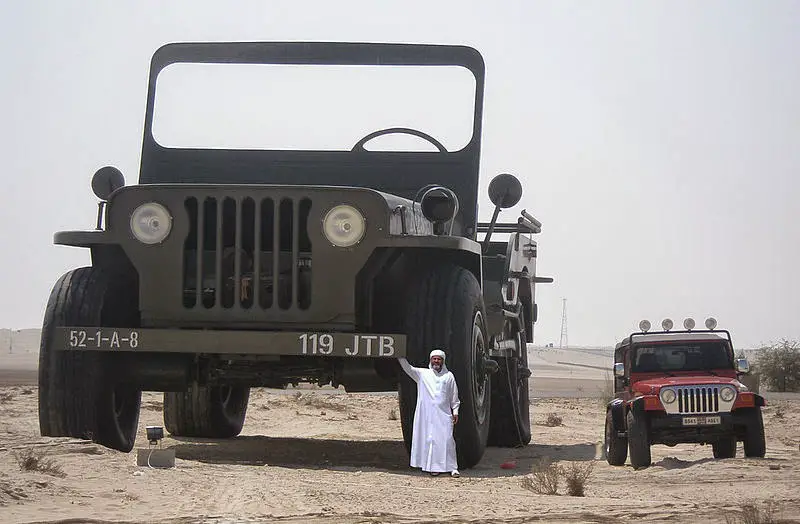The Jeep is the rugged, four-wheel drive vehicle known to be able to go just about anywhere. It had its origins in 1940, but it wasn’t initially known as a Jeep. How did this iconic vehicle get its name?
Unfortunately, there isn’t a clear-cut explanation of how the Jeep became known as the “Jeep,” but there are some good theories. It’s up to debate which one is best.
A Quick Little History
The Jeep started in June 1940, when the U.S. Army elicited bids from automakers for a “light reconnaissance vehicle.” Three companies ultimately took up the challenge — Bantam, Willys, and Ford. Willys designed and delivered a prototype called the Willys “Quad,” referring to the vehicle’s 4×4 system. The company only produced two prototypes.
Willys made an improved version called the Willys MA and was awarded a government contract in July 1941. The Willys MA was further upgraded and became the iconic Willys MB, which was in service with the military between 1941 and 1945. But when did it become known as the “Jeep?”
The Military Theory
One widely held theory was that the name “Jeep” was derived from the Army’s supposed abbreviation for a “General Purpose” vehicle or GP. This theory holds that letters were slurred together to get Jeep.
But there are claims that GP didn’t stand for “General Purpose,” and that the “G” actually indicated the vehicle was a government contract vehicle, and the “P” meant that it had an 80-inch wheelbase. This probably arose because Ford had a vehicle delivered to soldiers in 1941 called the Ford GP.
Another problem with this theory is that the word jeep had already been used earlier, around 1914, by U.S. Army mechanics in reference to new test vehicles, and tractors supplied to the Army in 1937 were known by the word as was the Boeing B-17 Flying Fortress. The word “Jeep” also appears in reference to “rugged trucks used for platoon general transport,” from an article in the Edmonton Journal in January 1941.
One of the events that may have helped cement the word “jeep” to what we know today may have come about from a story by the Associated Press on February 20, 1941, titled “Jeeps Creeps Up Capitol Steps.” The picture shows Senator James M. Mead and Representative J. Parnell Thomas, along with three Army sergeants, driving up the Capitol steps in what is described as the “Army’s new light trucks, known as ‘Jeeps.’”
The Popeye Theory
Another theory was that the word “jeep” derived from a character from a Popeye’s comic. In 1936, a character called Eugene the Jeep (who vocalized with “jeep, jeep”) was introduced as a dog and cat hybrid with a large nose. He had the ability to “go anywhere and do anything,” which also happens to be the motto for the Jeep brand. It’s thought that soldiers who were fans of Popeye may have caught on to Eugene the Jeep’s motto and applied this to those vehicles they were relying on during the war.
Willys-Overland applied for a trademark to use “Jeep” in 1943, but due to how the name originated, it wasn’t granted until 1950. The lowercase “jeep” often refers to those vehicles used prior to that time, and “Jeep” to any of the vehicles after the trademark was granted. One thing is certain, the Jeep has stood the test of time.
Sources: Motortrend, CJ Off-Road, Miracle Chrysler-Dodge-Jeep, Jeep, Word Origins
Other Interesting “Jeep” and “jeep” Facts
This jeep was created by Sheikh Hamad Bin Hamdan Al Nahyan, a member of the Abu Dhabi Royal Ruling Family. It is the largest motorized model of the Willys World War II Jeep, and it’s on display at the Emirates National Auto Museum. Source
In 1940, engineers at RCA called an RCA television demonstration unit a “jeep.” These units were used at radio stations and department stores in areas where television service was not yet available. Source
The iconic flat slotted grille with integrated headlights on a Jeep was originally a Ford design taken from their Pygmy model in the 1940s. Ford helped produce the Willys jeeps during World War II and found that their grille could be made more quickly and efficiently than the Willys’ design. After the war, Willys began to build civilian Jeeps, but they couldn’t use the grille because it was a Ford design. The company changed the version from a 9-slot grille to a 7-slot grille to trademark it. This is the grille that is seen on Jeeps today. Source
A jeep named “Old Faithful” was awarded a Purple Heart for “wounds,” which were two shrapnel holes in its windshield, during the shelling of Guadalcanal on October 13, 1942. The Willys jeep served four Marine generals through the Guadalcanal campaign and Bougainville invasion. It was later put on display at the Marine Corps Museum in Quantico, Virginia. Source




